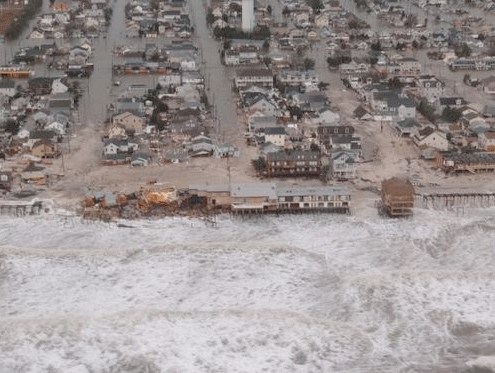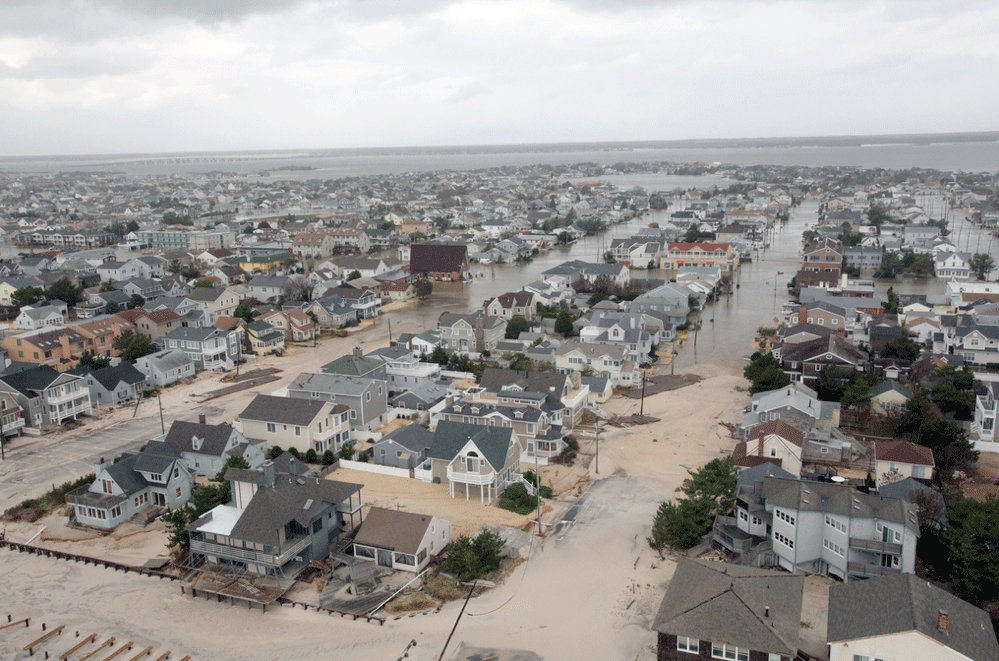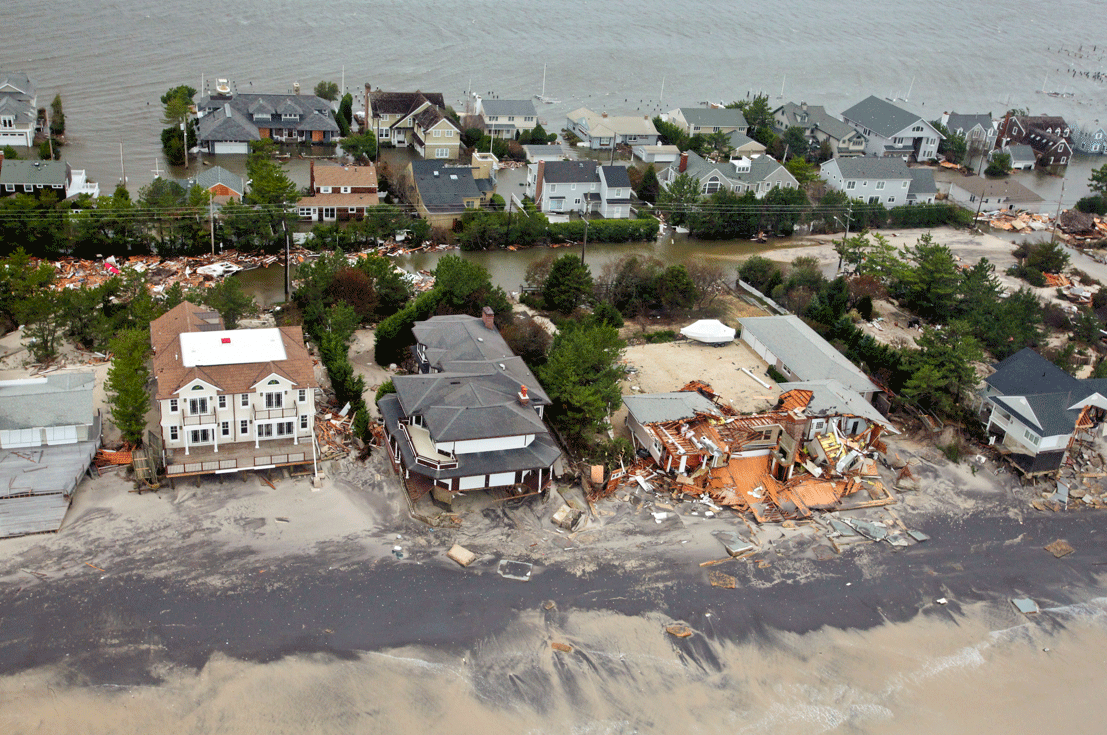Insuring for Climate Change
Air Date: Week of November 2, 2012

Sandy battered Atlantic City (Department of Defense)
Scientists expect more severe storms like Sandy as a result of climate change and insurance companies are paying attention. Steve Dishart, former communications manager for reinsurer Swiss Re, tells host Steve Curwood that rates wil rise and some properties will be uninsurable as climate change brings about more fierce weather.
Transcript
CURWOOD: It'll be months before the costs of super-storm Sandy are tallied but estimates currently range to 50 or 60 billion dollars or even more. Insurance companies will pick up the tab for part of that - and they're paying attention when scientists say climate change will increase the severity of storms.
Steve Dishart used to manage Communications for Zürich-based Swiss Re, a company that's part of the large reinsurance industry. Insurance companies manage their risks by buying policies against catastrophic loss from reinsurers. We reached Dishart at his home in Westchester County, just north of New York City where, after the storm, he's got no electricity or heat.

The New Jersey coast in the aftermath of Sandy (Photo: U.S. Air Force by Master Sgt. Mark C. Olsen)
DISHART: Well, I’m missing the heat but fortunately I have a wood burning stove so I’m sitting in front of my wood burner talking to you on my cell phone. This is the second time in exactly 12 months I’ve had to do exactly the same thing. Last year with the heavy snow that brought the trees down that brought the power down, and now we’re dealing with it again.
CURWOOD: Now, Steve, of course it’s too early to really know, but how big a deal is super-storm Sandy?
DISHART: The two largest losses in terms of weather have been hurricane Andrew and hurricane Katrina. I think this is going to be somewhere in between. I think that it’s hard to tell right now what the loss will be but you have to think about all the losses related to flooding in particular with homes all up and down the East Coast.
There’s also a business loss interruptions, which of course will be significant because we have one of the largest commercial regions in the country, so we’re talking very large impact and one of the most significant in our country’s history. But in the long run, I think the more important impact is on our thought process with regards to climate change.
CURWOOD: What’s the consensus in the insurance industry about climate change?

(US Department of Defense)
DISHART: I don’t want to speak for the entire industry, but I think there is a view within the reinsurance industry that climate change will continue to have an impact and continue to increase. And it’s not just about global warming, the issue is volatility and severity with regards to climate, and that is what’s changing. And that’s what we need to prepare for.
CURWOOD: Volatility - you mean that things just change rapidly?
DISHART: I mean that we have more events more often, they’re more severe, the floods are increased and the droughts are increased as well. This is a matter of climate change. This is happening and it is a reality. The fact that some people don’t want to buy into human contribution to climate change, to me, is unfortunate but irrelevant.
The climate is changing – there is a tremendous agreement among scientists that it is changing – and we’re beyond the point now where we can adjust and try to dampen the impact. In fact, sadly, we need to face the concept of adaption.
CURWOOD: Does this increase in the frequency and severity of these storms affect the ability of your industry to write policies?
DISHART: It certainly affects the pricing of policies. When you look at a situation and people want to get insurance, you have to say, well, what does that cost? Should we be subsidizing – through the government or through other means – people who desire to live out on an island or out somewhere that’s more vulnerable, or should they be paying a higher rate? Or not be insured and be able to self-insure.
CURWOOD: So, Munich Re recently put out a report just before this storm that was entitled: ‘Severe Weather in North America’, writing, and let me quote them here: “nowhere was the rising number of natural catastrophes more evident than in North America. The study shows a nearly quintupled loss events in North America, for the past three decades, compared to an increase factor of four in Asia and two in Europe.” Why do you think we’re seeing more climate-related natural catastrophes in North America than in other parts of the world?
DISHART: Well, keep in mind, particularly when it comes to hurricanes, that one of the generators of hurricanes is warm water. And we look at the Gulf of Mexico, we look at the hurricane generator, the warm water there. We also have extreme penetration of insurance in North America, which also increases the loss rates. If you took a map of North America, and you looked at migration over the last 30 to 40 years, and then you took a map and looked at the most severe events, it appears that North Americans like to move where disasters happen.
So, we’ve had all of these events, in Florida, along the Gulf, in California, and we have the most dense populations that we can moving to those areas. The unfortunate thing is, Steve, that we don’t see the tremendous losses when we look at third world countries, because tragically, the poorest areas in Nicaragua, in Dominican Republic, in Haiti, don’t have the housing, don’t have the protection that we have here. So they don’t have the insurance that we have here in the United States and in other parts of North America.
CURWOOD: You know there’s this saying that: “A crisis is a terrible thing to waste.” What do you think the crisis that’s been brought on by super-storm Sandy - what’s the benefit that could come out of this?
DISHART: Well, the benefit is that I’ve heard Mayor Bloomberg in New York City, I’ve heard Governor Cuomo, talk about climate change in an atmosphere where people are listening. Perhaps there is a learning moment here for us here to realize that climate change is happening that we cannot protect everybody from every potential risk and that we need to prepare for what may happen in the future.
CURWOOD: Steve Dishart is a former managing director of communications for Zürich-based Swiss Re, and now teaches at Baruch College (CUNY) in New York, thank you so much, sir.
DISHART: My pleasure, Steve. Good to be with you.
Links
Living on Earth wants to hear from you!
Living on Earth
62 Calef Highway, Suite 212
Lee, NH 03861
Telephone: 617-287-4121
E-mail: comments@loe.org
Newsletter [Click here]
Donate to Living on Earth!
Living on Earth is an independent media program and relies entirely on contributions from listeners and institutions supporting public service. Please donate now to preserve an independent environmental voice.
NewsletterLiving on Earth offers a weekly delivery of the show's rundown to your mailbox. Sign up for our newsletter today!
 Sailors For The Sea: Be the change you want to sea.
Sailors For The Sea: Be the change you want to sea.
 The Grantham Foundation for the Protection of the Environment: Committed to protecting and improving the health of the global environment.
The Grantham Foundation for the Protection of the Environment: Committed to protecting and improving the health of the global environment.
 Contribute to Living on Earth and receive, as our gift to you, an archival print of one of Mark Seth Lender's extraordinary wildlife photographs. Follow the link to see Mark's current collection of photographs.
Contribute to Living on Earth and receive, as our gift to you, an archival print of one of Mark Seth Lender's extraordinary wildlife photographs. Follow the link to see Mark's current collection of photographs.
 Buy a signed copy of Mark Seth Lender's book Smeagull the Seagull & support Living on Earth
Buy a signed copy of Mark Seth Lender's book Smeagull the Seagull & support Living on Earth

